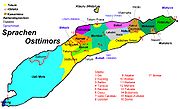
Waimoa language
Encyclopedia

Malayo-Polynesian languages
The Malayo-Polynesian languages are a subgroup of the Austronesian languages, with approximately 385.5 million speakers. These are widely dispersed throughout the island nations of Southeast Asia and the Pacific Ocean, with a smaller number in continental Asia...
spoken by about 3,000 people in northeast East Timor
East Timor
The Democratic Republic of Timor-Leste, commonly known as East Timor , is a state in Southeast Asia. It comprises the eastern half of the island of Timor, the nearby islands of Atauro and Jaco, and Oecusse, an exclave on the northwestern side of the island, within Indonesian West Timor...
. It is reported to be mutually intelligible
Mutual intelligibility
In linguistics, mutual intelligibility is recognized as a relationship between languages or dialects in which speakers of different but related languages can readily understand each other without intentional study or extraordinary effort...
with Kairui-Midiki. Waimoa is one of four languages, which are united called Kawaimina
Kawaimina
Kawaimina is a syllabic abbreviation used to refer to four languages and dialects of East Timor, specifically Kairui-Midiki, Waimaha, and Naueti, spoken by one or two thousand speakers each. It is a name used by linguists discussing the languages, not the speakers themselves...
.
Phonology
Waimoa is one of only two Austronesian languagesAustronesian languages
The Austronesian languages are a language family widely dispersed throughout the islands of Southeast Asia and the Pacific, with a few members spoken on continental Asia that are spoken by about 386 million people. It is on par with Indo-European, Niger-Congo, Afroasiatic and Uralic as one of the...
known to have a set of ejective
Ejective consonant
In phonetics, ejective consonants are voiceless consonants that are pronounced with simultaneous closure of the glottis. In the phonology of a particular language, ejectives may contrast with aspirated or tenuis consonants...
stops, the other being Yapese
Yapese language
Yapese is a language spoken by the people on the island of Yap .It belongs to the Austronesian languages, more specifically to the Oceanic languages...
:
| Bilabial Bilabial consonant In phonetics, a bilabial consonant is a consonant articulated with both lips. The bilabial consonants identified by the International Phonetic Alphabet are:... | Coronal Coronal consonant Coronal consonants are consonants articulated with the flexible front part of the tongue. Only the coronal consonants can be divided into apical , laminal , domed , or subapical , as well as a few rarer orientations, because only the front of the tongue has such... | Velar Velar consonant Velars are consonants articulated with the back part of the tongue against the soft palate, the back part of the roof of the mouth, known also as the velum).... | Glottal Glottal consonant Glottal consonants, also called laryngeal consonants, are consonants articulated with the glottis. Many phoneticians consider them, or at least the so-called fricative, to be transitional states of the glottis without a point of articulation as other consonants have; in fact, some do not consider... |
|
|---|---|---|---|---|
| Voiceless unaspirated Aspiration (phonetics) In phonetics, aspiration is the strong burst of air that accompanies either the release or, in the case of preaspiration, the closure of some obstruents. To feel or see the difference between aspirated and unaspirated sounds, one can put a hand or a lit candle in front of one's mouth, and say pin ... |
p | t | k | ʔ |
| Voiceless aspirated Aspiration (phonetics) In phonetics, aspiration is the strong burst of air that accompanies either the release or, in the case of preaspiration, the closure of some obstruents. To feel or see the difference between aspirated and unaspirated sounds, one can put a hand or a lit candle in front of one's mouth, and say pin ... |
pʰ | tʰ | kʰ | |
| Voiceless ejective Ejective consonant In phonetics, ejective consonants are voiceless consonants that are pronounced with simultaneous closure of the glottis. In the phonology of a particular language, ejectives may contrast with aspirated or tenuis consonants... |
pʼ | tʼ | kʼ | |
| Voiced plain | b | d | ɡ |

